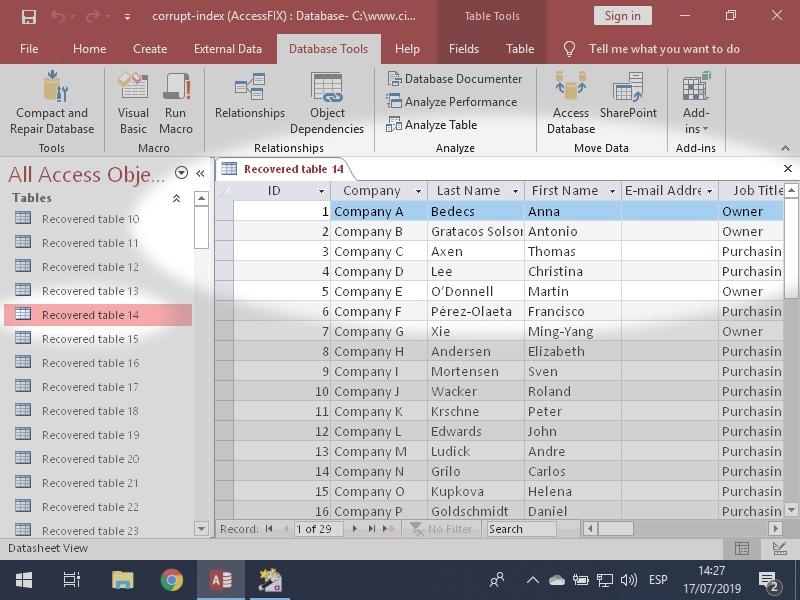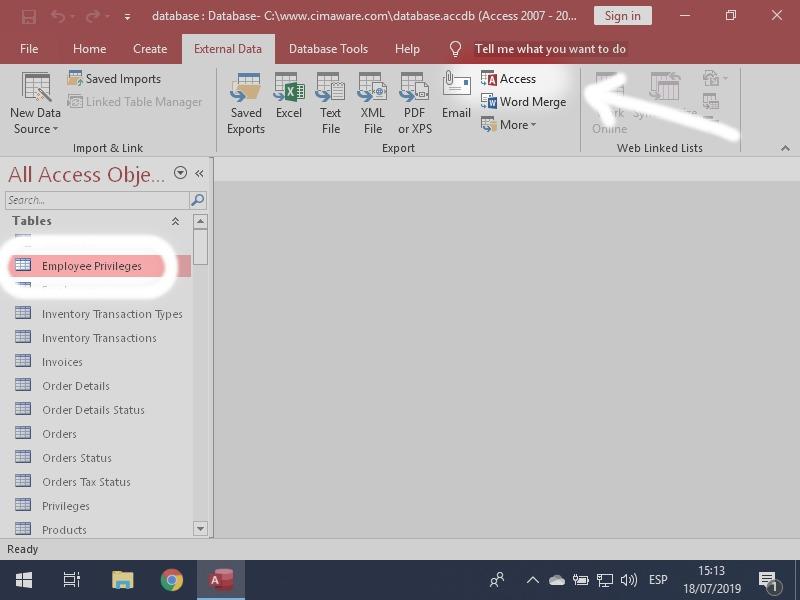
Microsoft Access is a powerful and widely-used database management system that provides individuals and businesses with extensive capabilities for storing, organizing, and analyzing their data. Whether you are a beginner seeking to harness its potential or an experienced user looking to enhance your skills, this article will guide you through the essential techniques and functionalities of Microsoft Access. From creating databases and designing tables to running queries and generating reports, we will explore various aspects of this versatile software, ensuring that you gain the necessary knowledge to utilize Microsoft Access effectively. Get ready to dive into the world of databases with this comprehensive tutorial, as we unravel the wonders and intricacies of Microsoft Access.
Introduction to Microsoft Access
Microsoft Access is a powerful tool that allows users to create and manage databases. Whether you are a beginner or an experienced user, this will provide you with the necessary knowledge to get started. In this post, we will explore the key features and functionality of Access, and provide you with tips and tricks for using this software effectively.
One of the primary features of Microsoft Access is its ability to store and organize large amounts of data. Access uses tables to store data, with each table containing rows and columns. You can think of a table as being similar to a spreadsheet, where each row represents a record and each column represents a different field. Access allows you to easily enter, edit, and delete data within these tables, making it an ideal tool for managing information.
In addition to tables, Microsoft Access also provides several other objects that can be used to enhance your database. These objects include forms, queries, and reports. Forms allow you to create a user-friendly interface for entering and viewing data. Queries allow you to search, sort, and analyze data in your tables. Reports allow you to generate professional-looking documents that summarize and present your data in a visually appealing manner.
Access also provides a wide range of powerful tools and functions that can help you manipulate and analyze your data. For example, you can use filters to retrieve specific records from a table. You can also use calculations and formulas to perform calculations on your data, such as adding or subtracting values or performing complex mathematical operations. Access even includes a built-in query designer, which allows you to easily create complex queries without needing to write any SQL code.
Another useful feature of Microsoft Access is its ability to integrate with other Microsoft Office applications. You can import and export data between Access and Excel, Word, and Outlook, making it easy to share and collaborate on your database with other users. You can also link Access tables to external databases or data sources, allowing you to combine data from multiple sources into a single database.
In conclusion, Microsoft Access is a versatile and powerful tool for creating and managing databases. By understanding the key features and functionality of Access, and learning how to use its tools effectively, you can unlock the full potential of this software. Whether you are a beginner or an experienced user, this has provided you with a solid foundation to start building and managing your own databases. Happy Accessing!

Navigating the User Interface and Accessing Databases
One of the most powerful tools for managing databases is Microsoft Access. With its easy-to-use interface and wide range of features, Access allows you to navigate through your databases seamlessly. In this post, we’ll walk you through the basics of in Microsoft Access.
The Navigation Pane
The navigation pane in Microsoft Access provides quick access to all the objects in your database. Located on the left side of the screen, it allows you to effortlessly switch between tables, queries, forms, reports, and more. To open an object, simply double-click on it in the navigation pane. You can also organize your database objects into groups and create custom views for easy access.
Tables: The Backbone of Your Database
Tables are the foundation of any database in Microsoft Access. They store the data in an organized manner and allow you to sort, filter, and manipulate that data. To view a table, click on the “Tables” category in the navigation pane and double-click on the desired table. From there, you can add, edit, or delete records, as well as create relationships between tables for more complex databases.
Queries: Extracting Specific Data
Queries in Microsoft Access allow you to extract specific data from your tables. Whether you need to create custom reports or perform complex searches, queries are an essential tool. To create a query, click on the “Queries” category in the navigation pane and select “New.” From there, you can choose the tables or queries you want to include, specify the fields, and set criteria to filter the data. You can also use SQL (Structured Query Language) to create more advanced queries.
Forms: User-Friendly Data Entry
Forms in Microsoft Access provide a user-friendly interface for entering and viewing data. They allow you to customize the layout, control the input, and add validation rules to ensure data integrity. To create a form, click on the “Forms” category in the navigation pane and select “New.” You can then choose to create a form using the Form Wizard or design it manually. Forms are particularly useful when you want to restrict access to certain fields or streamline the data entry process.
Reports: Presenting Your Data
Reports in Microsoft Access allow you to present your data in a professional and meaningful way. Whether you need to create simple lists or complex financial statements, reports provide a wide range of options for formatting and organizing your data. To create a report, click on the “Reports” category in the navigation pane and select “New.” From there, you can choose the tables or queries to include, select the fields to display, and apply formatting options such as grouping, sorting, and calculations.
in Microsoft Access is crucial for managing your data effectively. By mastering the navigation pane, understanding the role of tables, queries, forms, and reports, you’ll be well-equipped to handle even the most complex database tasks. Stay tuned for our upcoming posts on more advanced features of Microsoft Access!

Creating Tables and Defining Fields in Microsoft Access
In this section, we will explore the process of . Tables are the fundamental building blocks of any database, and designing them correctly is crucial for organizing and storing your data efficiently. By following these steps, you’ll be able to create tables and define fields that meet the specific requirements of your project.
-
Navigate to the “Table Design” view: To create a new table, open Microsoft Access and click on the “Table Design” icon. This will open a new window where you can define the structure of your table.
-
Adding fields: In the “Table Design” view, you can start adding fields to your table. Each field represents a specific attribute or data point you want to store. Give each field a unique and descriptive name, and select the appropriate data type from the dropdown menu. For example, if you want to store names, you can choose the “Text” data type.
-
Defining field properties: After adding fields, you can define their properties to further specify how they should behave. This can include options such as whether a field is required, what its maximum length should be, and whether it should allow duplicate values. By customizing these properties, you can ensure data integrity and enforce certain rules within your table.
-
Creating relationships: One of the powerful features of Microsoft Access is the ability to establish relationships between tables. This allows you to create more robust databases by connecting related information. To create a relationship, you’ll need to define a primary key in one table and a foreign key in another table. This way, you can link the records in the two tables based on their corresponding keys.
-
Testing and refining your table: Once you have defined the fields and properties of your table, it’s essential to test it and ensure that it functions as intended. Enter some sample data into your table, and verify that it is stored correctly. Make any necessary adjustments to the field properties or table structure if needed and continue testing until you are satisfied with the results.
By following these steps, you can confidently create tables and define fields in Microsoft Access. Remember that proper table design and field definition are essential for maintaining data integrity and optimizing your database for efficient querying and retrieval. Experiment with different field properties and relationships to fully harness the power of Microsoft Access and build a robust and scalable database solution.
Building Queries to Extract and Analyze Data
Microsoft Access is a powerful tool that allows users to manage large amounts of data efficiently. One of the key features that sets it apart is its ability to build queries to extract and analyze data. With Access, you can easily create complex queries to retrieve specific information from your database, helping you gain valuable insights and make informed decisions.
To begin building queries in Microsoft Access, you’ll need to open your database and navigate to the “Create” tab. Here, you’ll find the “Query Design” option, which opens a graphical interface for creating your queries. Alternatively, you can use the “Query Wizard” to guide you through the process step by step.
Once you’re in the query design view, you can add tables to your query by selecting them from the “Show Table” window. Access allows you to join multiple tables together, enabling you to extract data from different sources and perform complex analysis. To join tables, simply drag and drop the fields you want to use as the basis for the relationship.
After adding your tables, you can start adding specific criteria to filter the data you want to extract. With Access, you have a range of operators at your disposal, such as “Equals,” “Not Equals,” “Greater Than,” “Less Than,” and many more. Additionally, you can use logical operators like “AND” and “OR” to combine multiple criteria and create more sophisticated queries.
Once your query is built, you can execute it to view the results. Access provides a variety of output options, including tables, datasheets, and forms. You can also sort and group your data to further analyze and summarize the information. By utilizing these features effectively, you can gain a deeper understanding of your data, identify patterns, and uncover meaningful insights crucial for decision-making.
In conclusion, Microsoft Access offers a robust set of tools for . Its user-friendly interface, coupled with its powerful features, makes it a valuable tool for data management and analysis. By leveraging Access’s query-building capabilities, you can efficiently retrieve the specific information you need, apply various criteria to filter your data, and gain valuable insights to support your decision-making process. Whether you’re a beginner or an advanced user, Access provides the flexibility and functionality needed to navigate through complex datasets and uncover hidden patterns.
Designing Forms and Reports for Data Presentation
Microsoft Access is a powerful database management system that allows users to organize, store, and manipulate large amounts of data. With its user-friendly interface and extensive range of features, it is an excellent tool for . In this post, we will explore some tips and tricks to help you effectively utilize Microsoft Access for creating visually appealing and functional forms and reports.
To begin, it is essential to consider the layout and design of your forms and reports. Create a clear and logical structure by grouping related fields and controls together. Utilize different types of controls, such as text boxes, check boxes, and drop-down lists, to capture and present data. By using labels and tooltips, you can provide guidance and information to users, enhancing the user experience.
Formatting plays a crucial role in making your forms and reports visually appealing. Take advantage of Microsoft Access’s formatting options to create a professional-looking presentation. You can customize fonts, colors, and backgrounds to match your organization’s branding. Similarly, aligning text and controls properly will make the information easy to read and navigate.
Another important aspect of designing forms and reports is ensuring data accuracy and integrity. Use input masks and validation rules to restrict data entry to specific formats or ranges. This will prevent errors and maintain data consistency. Additionally, consider implementing calculated fields and aggregate functions to perform calculations or summarize data, providing valuable insights on your reports.
It is often beneficial to add interactive elements to your forms and reports, allowing users to interact and manipulate the data. Microsoft Access provides various tools for this purpose. For instance, you can include command buttons that perform specific actions, such as saving, printing, or exporting data. You can also utilize subforms and subreports to display related information within a main form or report, enhancing data navigation and analysis.
Lastly, regularly review and refine your forms and reports to ensure they meet the evolving needs of your organization. Analyze user feedback and identify areas for improvement. Additionally, take advantage of Microsoft Access’s reporting and analysis features, such as pivot tables and charts, to gain insights into your data and present meaningful information in a visual format.
In conclusion, designing forms and reports in Microsoft Access is a powerful way to present data effectively and efficiently. By following these tips and utilizing the various features of Microsoft Access, you can create visually appealing, user-friendly forms and reports that enhance data presentation and analysis for your organization.
Q&A
Q&A: How to Use Microsoft Access
Q1: What is Microsoft Access, and what can it be used for?
A: Microsoft Access is a relational database management system (RDBMS) that allows users to store, manage, and analyze large amounts of data. It provides an intuitive graphical interface, making it accessible for users to create databases, develop queries, design forms and reports, and more.
Q2: How do I create a database in Microsoft Access?
A: To create a new database, open Microsoft Access and click on the “Blank Database” option. Choose a name and location for your database, and click “Create”. This will create a new, empty database file that you can start populating with tables, forms, queries, and other elements.
Q3: How do I design and manage tables in Microsoft Access?
A: To design tables, go to the “Table Design” view and define the fields (columns) and their properties. You can specify data types, set primary keys, establish relationships between tables, and apply validations if needed. To manage tables, you can add, delete, or modify records using the table view or forms.
Q4: How can I query data in Microsoft Access?
A: Access provides a query builder tool that allows you to create complex queries with ease. Simply open the “Query Design” view, select the desired tables or queries, define the criteria and desired output fields, and execute the query. The results can be displayed directly or saved as separate tables.
Q5: Can I create custom forms and reports in Microsoft Access?
A: Absolutely! Access allows you to design custom forms and reports tailored to your specific needs. Using the form designer or report designer, you can add various controls, organize and format data, apply calculations, and incorporate visual elements. These forms and reports enhance the usability and presentation of your data.
Q6: How can I secure my Microsoft Access database?
A: Access provides security features to protect your database from unauthorized access. You can set user-level permissions and passwords to limit who can view, modify, or delete data. Additionally, you can encrypt the database file to prevent unauthorized access to the file itself.
Q7: Are there any resources to learn more about Microsoft Access?
A: Yes, there are plenty of resources available for learning Microsoft Access. Microsoft’s website offers documentation, tutorials, and videos to get you started. You can also find online courses, forums, and user communities that provide additional support and tips for using Access effectively.
Q8: Can I use Microsoft Access with other Microsoft Office applications?
A: Yes, Microsoft Access seamlessly integrates with other applications in the Microsoft Office suite. This allows you to import and export data to and from Excel, connect Access data to Word for mail merges, or even link Access tables in PowerPoint presentations. The integration enhances your ability to work with data across different platforms.
Q9: Can I share my Microsoft Access database with others?
A: Yes, you can share your Access database with others in various ways. You can create a standalone copy of your database file or convert it into a runtime version that requires no installation of Access. Alternatively, you can split the database into a front-end (forms, reports, queries) and a back-end (tables), storing the latter on a shared network folder for multiple users to access simultaneously.
Q10: Is there a maximum limit to the amount of data I can store in Microsoft Access?
A: Yes, there is a maximum size limit for an Access database, usually two gigabytes (GB). However, by employing techniques like data archiving, splitting tables, and compacting the database, you can efficiently manage and store much larger volumes of data in Access.
Remember, Microsoft Access offers a wide range of features and capabilities for managing and analyzing data effectively. Exploring its various tools and functionalities will help you unleash the full potential of this powerful database management system. In conclusion, Microsoft Access is a powerful database management tool that can greatly enhance your efficiency and effectiveness in handling large amounts of data. By using the step-by-step guidelines provided in this article, you now have a clear understanding of the key features and functionalities of Access. Whether you are a professional seeking to streamline your workflows or a student looking for an organized way to manage your data, Access offers a user-friendly interface and a range of tools that can cater to your specific needs. Remember to regularly practice and explore the various features of Access to fully maximize its potential. With practice, you will gain the necessary skills and confidence to create and manage databases seamlessly. So, go ahead, dive into the world of Microsoft Access, and unlock its full potential for all your data management needs.






